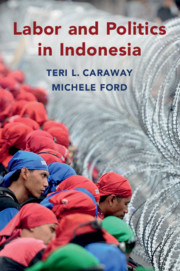Book contents
- Labor and Politics in Indonesia
- Cambridge Studies in Contentious Politics
- Labor and Politics in Indonesia
- Copyright page
- Contents
- Figures
- Tables
- Acknowledgments
- Abbreviations
- 1 Introduction
- 2 The Street and the Ballot Box
- 3 National and Local Policy Struggles, 1998–2008
- 4 Shifting to Offense
- 5 Local Executive Races
- 6 Legislative Contests
- 7 Building a Working-Class Constituency
- 8 Conclusion
- References
- Index
- Cambridge Studies in Contentious Politics
3 - National and Local Policy Struggles, 1998–2008
Published online by Cambridge University Press: 02 March 2020
- Labor and Politics in Indonesia
- Cambridge Studies in Contentious Politics
- Labor and Politics in Indonesia
- Copyright page
- Contents
- Figures
- Tables
- Acknowledgments
- Abbreviations
- 1 Introduction
- 2 The Street and the Ballot Box
- 3 National and Local Policy Struggles, 1998–2008
- 4 Shifting to Offense
- 5 Local Executive Races
- 6 Legislative Contests
- 7 Building a Working-Class Constituency
- 8 Conclusion
- References
- Index
- Cambridge Studies in Contentious Politics
Summary
This chapter examines the first decade of worker mobilization in post-Suharto Indonesia. At the national level, the labor movement experienced stunning success in shaping labor law reform during this period. In the absence of strong ties to political parties, unions created mayhem in the streets to capture the attention of politicians and raise the cost of supporting laws that unions opposed. Since both the executive and the legislature had to approve labor legislation, unions could stop the enactment of antilabor laws by peeling away legislative support. This task was facilitated by government instability and weak presidential control over coalition partners and the fact that the Minister of Manpower was from a labor background in some years. At the local level, by contrast, unions had fewer points of entry and less leverage. Although newly created tripartite wage councils gave workers a voice in wage-setting, executives had the final authority to determine minimum wages increases, and they were relatively immune to pressure from workers until direct elections were phased in between mid-2005 and late 2008.
Keywords
- Type
- Chapter
- Information
- Labor and Politics in Indonesia , pp. 48 - 69Publisher: Cambridge University PressPrint publication year: 2020

